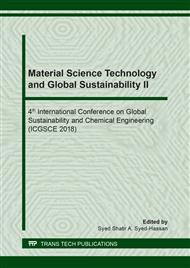[1]
E. Derman, R. Abdullaa, H. Marbawi, M.K. Sabullah, Oil palm empty fruit bunches as a promising feedstock for bioethanol production in Malaysia, Renewable Energy. In Press (2018).
DOI: 10.1016/j.renene.2018.06.003
Google Scholar
[2]
M.H. Sulaiman, Y. Uemura, M.T. Azizan, Procedia Engineering. 148 (2016) 573-579.
Google Scholar
[3]
A.K. Mohd Omar, T.LTengku Norsalwani, M.S. Asmah, Z.Y. Badrulhisham, A. Mat Easa, F. Mohd Omar, M.S. Hossain, M.H. Zuknik, N.A. Nik Norulaini, Implementation of the supercritical carbon dioxide technology in oil palm fresh fruits bunch sterilization: A review, Journal of CO2 Utilization. (2018) 205-215.
DOI: 10.1016/j.jcou.2018.03.021
Google Scholar
[4]
M. Jonoobi, A. Khazaeian, P. Md. Tahir, S.S. Azry, K. Oksman, Characteristics of cellulose nanofibers isolated from rubberwood and empty fruit bunches of oil palm using chemo-mechanical process, Cellulose. 18 (2011) 1085.
DOI: 10.1007/s10570-011-9546-7
Google Scholar
[5]
S. Palamae, P. Dechatiwongse, W. Choorit, Y. Chisti, P. Prasertsan, Cellulose and hemicellulose recovery from oil palm empty fruit bunch (EFB) fibers and production of sugars from the fibers, Carbohydrate Polymers. 155 (2017) 491-497.
DOI: 10.1016/j.carbpol.2016.09.004
Google Scholar
[6]
N.D. Vu, H.T. Tran, N.D. Bui, C.D. Vu, and H.V. Nguyen, Lignin and Cellulose Extraction from Vietnam's Rice Straw Using Ultrasound-Assisted Alkaline Treatment Method, International Journal of Polymer Science.(2017).
DOI: 10.1155/2017/1063695
Google Scholar
[7]
W. Katinonkul, J.S. Lee, S.H. Ha, J.Y. Park, Enhancement of enzymatic digestibility of oil palm empty fruit bunch by ionic-liquid pretreatment, Energy. 47 (2012) 11-16.
DOI: 10.1016/j.energy.2012.06.050
Google Scholar
[8]
A.H. Faris, A. Abdul Rahim, M.N. Mohamad Ibrahim, M.H. Hussin, A.M. Alkurdi, A. Salehabadi, Investigation of oil palm based Kraft and auto-catalyzed organosolv lignin susceptibility as a green wood adhesives, International Journal of Adhesion and Adhesives . 74 (2017) 115-122.
DOI: 10.1016/j.ijadhadh.2017.01.006
Google Scholar
[9]
F.S. Chakar, A.J. Ragauskas, Review of current and future softwood kraft lignin process chemistry, Industrial Crops and Products. 20 (2004) 131-141.
DOI: 10.1016/j.indcrop.2004.04.016
Google Scholar
[10]
P. Figueiredo, K. Lintinen, J.T. Hirvonen, M.A. Kostiainen, H.A. Santos, Properties and chemical modifications of lignin: Towards lignin-based nanomaterials for biomedical applications, Progress in Materials Science. 93 (2018) 233-269.
DOI: 10.1016/j.pmatsci.2017.12.001
Google Scholar
[11]
B.V.K.J. Schmidt, V. Molinari, D. Esposito, K. Tauer, M. Antonietti, Lignin-based polymeric surfactants for emulsion polymerization, Polymer. 112 (2017) 418-426.
DOI: 10.1016/j.polymer.2017.02.036
Google Scholar
[12]
X. Ji, M. Guo, Preparation and properties of a chitosan-lignin wood adhesive, International Journal of Adhesion and Adhesives. 82 (2018) 8-13.
DOI: 10.1016/j.ijadhadh.2017.12.005
Google Scholar
[13]
M. Boonterm, S. Sunyadeth, S. Dedpakdee, P. Athichalinthorn, R. Techapiesancharoenkij, Characterization and comparison of cellulose fiber extraction from rice straw by chemical treatment and thermal steam explosion, Journal of Cleaner Production. 134 (2016) 592-599.
DOI: 10.1016/j.jclepro.2015.09.084
Google Scholar
[14]
W. Stelte, Steam explosion for biomass pre-treatment, Danish Technological Institute. (2014).
Google Scholar
[15]
P. Khalili, K. Yeow, T.I. Kong, Comparative Thermal and Physical Investigation of Chemically Treated and Untreated Oil Palm EFB Fiber, Materials Today: Proceedings. 5 (2018) 3185-3192.
DOI: 10.1016/j.matpr.2018.01.127
Google Scholar
[16]
W.H. Chen, P.C. Kuo, A study on torrefaction of various biomass materials and its impact on lignocellulosic structure simulated by a thermogravimetry, Energy. 35 (2010) 2580-2586.
DOI: 10.1016/j.energy.2010.02.054
Google Scholar
[17]
X. Cao, L. Zhong, X. Peng, S. Sun, R. Sun, Comparative study of the pyrolysis of lignocellulose and its major components: Characterization and overall distribution of their biochars and volatiles, Bioresource Technology. 155 (2014) 21-27.
DOI: 10.1016/j.biortech.2013.12.006
Google Scholar


